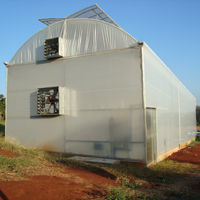Wireless sensor network to identify the reduction of meteorological gradients in greenhouse in subtropical conditions

Published: 13 November 2020
Abstract Views: 1909
PDF: 558
HTML: 16
HTML: 16
Publisher's note
All claims expressed in this article are solely those of the authors and do not necessarily represent those of their affiliated organizations, or those of the publisher, the editors and the reviewers. Any product that may be evaluated in this article or claim that may be made by its manufacturer is not guaranteed or endorsed by the publisher.
All claims expressed in this article are solely those of the authors and do not necessarily represent those of their affiliated organizations, or those of the publisher, the editors and the reviewers. Any product that may be evaluated in this article or claim that may be made by its manufacturer is not guaranteed or endorsed by the publisher.
Similar Articles
- Daniele Torreggiani, Valentina Corzani, Stefano Benni, Patrizia Tassinari, Design of farm winery façades for the optimisation of indoor natural lighting: a case study , Journal of Agricultural Engineering: Vol. 44 No. 1 (2013)
- Juan Ãngel Mintegui Aguirre, José Carlos Robredo Sánchez, Carlos de Gonzalo Aranoa, Pablo Huelin Rueda, Jorge Fallas, Felipe Cisneros, Pedro Cisneros, Adriana Urciuolo, Rodolfo Iturraspe, Forest use strategies in watershed management and restoration: application to three small mountain watersheds in Latin America , Journal of Agricultural Engineering: Vol. 45 No. 1 (2014)
- Lara Riguccio, Laura Carullo, Patrizia Russo, Giovanna Tomaselli, A landscape project for the coexistence of agriculture and nature: a proposal for the coastal area of a Natura 2000 site in Sicily (Italy) , Journal of Agricultural Engineering: Vol. 47 No. 2 (2016)
- Salahudin Zahedi, Kaka Shahedi, Mahmod Habibnejad Rawshan, Karim Solimani, Kourosh Dadkhah, Soil depth modelling using terrain analysis and satellite imagery: the case study of Qeshlaq mountainous watershed (Kurdistan, Iran) , Journal of Agricultural Engineering: Vol. 48 No. 3 (2017)
- Salvatore Praticò, Raimondo Tripodi, Viviana Tirella, Salvatore Di Fazio, Francesco Barreca, Giuseppe Modica, Proposal of an integrated 3D architectural survey method for application in historic agri-food building analysis and representation , Journal of Agricultural Engineering: Vol. 54 No. 3 (2023)
- Silvana Fuina, Giuseppe C. Marano, Giuseppe Puglisi, Domenico De Tommasi, Giacomo Scarascia-Mugnozza, Thermo-mechanical response of rigid plastic laminates for greenhouse covering , Journal of Agricultural Engineering: Vol. 47 No. 3 (2016)
- Simona M.C. Porto, Giulia Castagnolo, Francesca Valenti, Giovanni Cascone, Kernel density estimation analyses based on a low power-global positioning system for monitoring environmental issues of grazing cattle , Journal of Agricultural Engineering: Vol. 53 No. 2 (2022)
- Giovanni Francesco Ricci, Faouzi Zahi, Ersilia D'Ambrosio, Anna Maria De Girolamo, Giuseppe Parete, Taha-Hocine Debieche, Francesco Gentile, Evaluating flow regime alterations due to point sources in intermittent rivers: A modelling approach , Journal of Agricultural Engineering: Vol. 53 No. 2 (2022)
- Enrico Antonio Chiaradia, Arianna Facchi, Olfa Gharsallah, Marco Romani, Gian Battista Bischetti, Claudio Gandolfi, Water balance of rice plots under three different cultivation methods: first season results , Journal of Agricultural Engineering: Vol. 44 No. s2 (2013): Proceedings of the 10th Conference of the Italian Society of Agricultural Engineering
- So Ishizaki, Hironori Hirai, Takayasu Sakagaito, Tomohiro Takeyama, Naoyuki Oido, Tokuo Tamura, Mikio Mizutani, Yoshiki Watanabe, Mikio Umeda, Development of a transplanter-based transplanter for vegetable seedlings cultured in a cuttable nursery mat , Journal of Agricultural Engineering: Vol. 55 No. 2 (2024)
<< < 3 4 5 6 7 8 9 10 11 12 > >>
You may also start an advanced similarity search for this article.

 https://doi.org/10.4081/jae.2020.1105
https://doi.org/10.4081/jae.2020.1105






